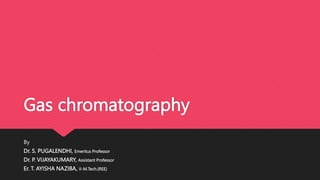
8. Gas chromatography.pptx
- 1. Gas chromatography By Dr. S. PUGALENDHI, Emeritus Professor Dr. P. VIJAYAKUMARY, Assistant Professor Er. T. AYISHA NAZIBA, II-M.Tech.(REE)
- 2. Principle Gas chromatography is a technique by which a mixture is separated into its constituents by a moving gas phase passing over a stationary adsorbent. The stationary phase may be either liquid or solid. In this chromatography, if adsorption process is taking place, the technique is known as gas-solid chromatography (GSC), while it is called gas-liquid chromatography (GLC), when partition process is taking place. In GSC, the column is packed with an active solid stationary phase and the components of the mixture are distributed between the gas phase and .the active solid phase. Due to differences in adsorption behavior of components of mixture, the separation is achieved. In GLC, the column is packed with a porous solid (of large surface area), which is coated with a thin- layer of a non-volatile liquid (stationary phase). Separation takes place due to difference in partitioning of sample between the mobile gas phase and thin-layer of liquid coated on inert support.
- 3. The sample mixture is introduced quickly into the moving carrier gas (such as N2, He, H2, Ar, etc.). The mixture is then swept along through the thermo stated GLC or GSC column. During the passage of mixture through column, the components of the mixture distribute themselves between the two phases. Some components are absorbed or adsorbed by the stationary phase better' than others, and hence, they are retained for longer time in the column. Thus, each component of the mixture is carried along the column at different rates and finally emerge from the column at different time. In other words, the time for passage through the column is characteristic for each component. As the component leaves the column, it is detected by instrumental means. A strip chart recorder, attached to the detector, shows a peak for each component, which is separated. The size of the peaks indicates the amount of that particular component in the mixture and its location on the chart indicates its nature. The apparatus employed is called gas chromatograph and the series of peaks obtained, is called chromatogram.
- 4. Instrumentation A gas chromatograph consists of: A supply of a carrier-gas (He, Ar or N2) from a high-pressure cylinder having a pressure regulator and flow meters. A sample injection system. . The separation column made from variety of materials including glass, copper, stainless steel, cupro- nickel or organic polymer (Teflon). Packed column normally are used in length of 0.7to2 m; while open tubular columns have length between 30 to 300 m. The detector situated at the exit of the separation column which senses and measures the small amount of the separated components present in the carrier-gas leaving the column. Commonly used detectors are thermal conductivity detector, and flame ionization detector. (The temperature of the detector compartment must be sufficiently high prevent condensation of sample vapours, yet it should not cause sample decomposition). The recorder / integrator with pc is fed by the output of the detector. Thermo stated compartment for the column and detector.
- 5. Merits It aims at producing only one peak" per component, maximum height per peak, minimum peak width and minimum retention time. A very small quantity of the sample is sufficient for analysis, since the sensitivity of this method is very high. It gives good precision and accuracy. It provides a quick and easy way of determining the different components of a mixture, together with the presence of impurities in the substance or in the identification of a compound. Hence, it is more suitable for routine analysis.
- 6. Demerits It is only suitable for compounds having sufficient volatility and thermal stability. In the separation of a number of components of similar type, but widely varying volatility, difficulty arises, if the experiment is carried out at constant temperature(isothermal). The low boiling components are eluted quickly and bunch together on the record chart output. On the other hand, the less volatile components take much longer time and hence, their peaks are broader and shallower. This difficulty, however, can be overcome by increasing temperature of the entire column at a uniform rate using a programmable furnace. By doing so, the peaks become more evenly distributed along the chart-paper and more nearly equal in sharpness.
- 8. Chromatogram
